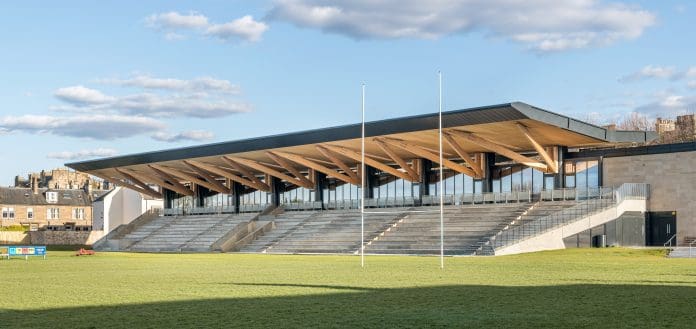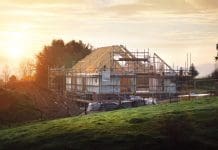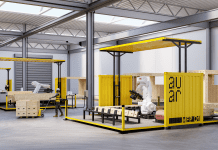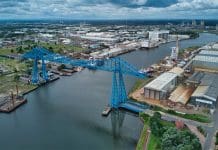Mass Timber has numerous benefits and is an essential tool to meet sustainability goals, yet is still not used to maximum effect throughout the construction industry
Mass timber is now making its presence known and forcing change, particularly as the industry navigates the eco-friendly route to meet looming Net Zero goals.
However, some still hold reservations regarding the material, despite the various benefits it provides.
Traditional timber kit construction has been used in Scotland for centuries, and with 75% of Scotland’s homes built from timber, it can be difficult to rationalise why people are reluctant to implement mass timber within their projects.
With advantages ranging from its lightweight nature and the timeframe to build significantly less than traditional materials to concerns over financial costs and the fire risks involved, it is clear the industry is on the fence on which route to pursue, whether that is the environmental or more understood traditional methods, but it is vital they choose correctly.
Mass timber vs traditional timber
It is important to identify what mass timber buildings involve and the difference between traditional timber kit construction and engineered timber.
Mass timber construction utilises modern engineered timber elements such as Glulam beams and Cross Laminated Timber (CLT) panels. These are created by glueing timber elements together in order to improve strength and stiffness as well as create larger elements.
Mass timber has been implemented in various areas, including office spaces and schools, with many using this as a way to improve their ESG (Environmental and Social Governance) credentials and its contribution to employee well-being, which can lead to improved health and overall workplace satisfaction.
As well as this, the material is aesthetically pleasing and links with the idea of Biophilic design, meaning bringing the natural outside environment inside.
Similarly, with schools, it is said that a natural environment can reduce stress levels and improve learning outcomes.
As a consultancy, we are seeing more clients ask for exposed timber finishes that the construction can offer due to the aesthetic benefits.
Timber generally is becoming more favoured across the sector because of the unique benefits it provides, specifically on timing.
Building with mass timber is estimated to be 25% faster than other materials, which is a huge bonus compared to projects using steel and concrete which can take longer to produce.
Mass timber helps efficient construction
This type of construction has seen significant reductions in overall programme length on a number of projects, bringing with it the associated cost savings. It also utilises off-site manufacturing principles leading to reduced deliveries to the site, causing less congestion, as well as greater tolerances and reduced material wastage.
Alongside being a sustainable material, mass timber also has various benefits as it is lightweight and easily buildable but can also be easily designed to be demountable, tying in nicely with circular economy principles.
This means that if, in the future, a building’s use or functionality is no longer required, the timber structure can be dismantled and reused within the construction industry elsewhere. Using materials such as mass timber, steel, and demountable materials, helps create a reusable market, which is something the industry desperately needs if it is to reduce its demand for these resources.
It is hoped that one day we will achieve an urban forest where the buildings can be harvested for their materials as required.
If the UK Government were to push the use of mass timber to supplement its green agenda, it would be great to see support for a Cross Laminated Timber (CLT) manufacturing plant in Scotland. This could help create more jobs and help drive forward the green economy by utilising the available timber resources in Scotland.
What are the pros and cons of mass timber?
Whilst mass timber is a great material for a number of projects, it would be wrong to suggest that it should be used for all buildings. As with all materials, its pros and cons must be respected and used in appropriate settings.
For small-scale projects such as houses using traditional timber kit is the most materially efficient, sustainable and cost-effective solution. However, we would not necessarily advocate for mass timber solutions at this scale without bespoke requirements.
Similarly, for large high-rise buildings, higher strength materials are more appropriate such as steel or concrete. Having said this, there are some great examples of high-rise mass timber buildings, such as the Mjøstårnet building in Norway. Buildings such as this demonstrate just how far we can go with mass timber, although I am not suggesting that this should be the norm.
In my view, it is important for those in the industry to keep innovating and pushing the boundaries of mass timber construction in order to increase its prevalence and help bring down the industry’s carbon footprint. Too often, designers opt for using steel and concrete as the easy and familiar route, and this approach needs to be challenged more regularly.
In my experience working in both London and now coming back to work in Edinburgh, it is interesting to see the difference in approach to using timber generally. Scotland champions using timber kit construction which should be taken as an example to the rest of the industry in the UK.
While it is understandable that using the material brings reservations to some, likely due to unfamiliarity and uncertainty when it comes to design and financial concerns, it can’t be simply pushed aside as an option.
There is a perception that timber is a material that is susceptible to moisture damage and that it can become expensive to replace if it becomes damaged. Whilst this is true, it is a risk that can be vastly reduced if it is designed and installed correctly and the buildings are adequately maintained.
Although it is prone to water damage more quickly compared to other traditional construction materials, moisture ingress damages all materials, and the approach to this should be a reduced risk due to detailing and maintenance rather than neglect.
The industry may also be apprehensive about the idea of using it due to concerns over high-risk fire hazards.
How to ensure health and safety in timber construction
However, there are various rules and regulations in place to combat this and to ensure the building is safe such as The Structured Timber Mass sixteen steps guide. Specifically in Scotland, there are construction firms who have specialised knowledge and expertise in building with all forms of timber construction, which significantly reduces this risk.
For those starting out on a project, this is vital as they can assist with any qualms individuals in the industry may have. Getting a suitable fire engineer involved in your project at an early stage is key to designing successfully in mass timber.
Inevitably, mass timber has been avoided in some projects due to a lack of knowledge and skillset. This is why it is important to have the right team present in project discussions to convey the need to use the material and why it isn’t something the industry should hide from but utilise.
There are many experts out there who can offer the design expertise required to deliver a wonderful mass timber project and leverage all the benefits of the material.
As someone passionate about mass timber and the sustainable aspect it provides, I would urge the industry not to shy away from the unknown but to get to know the value before dismissing it.
If you are unsure about the material, read about it and have conversations on it, attend relevant workshops, and ensure the right people are in the room to advise and consult your design team. There are many resources out there to assist with people’s knowledge.
Despite some pushback from the industry, the future of mass timber is bright, and the industry across the UK is starting to take steps to utilise and upskill on it where possible. With Net Zero goals in the near distant future, the sector has to shake up the way they do things. I hope to see more of the industry building with timber where they can and following Scotland’s prime example in utilising timber where possible.
Ewan Duffin
Associate Director
Harley Haddow

















